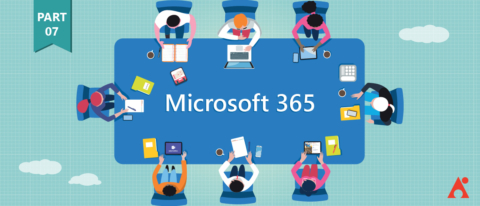Why Consolidating My Work in Microsoft Teams Was a Game Changer (My Teams #7)

New to Microsoft Teams and want to learn the best tips from industry experts? Check out our free webinar on-demand “Beginner to Super User: Top 10 Microsoft Teams Tips!”
The “My Teams” series is broken into the following categories. Click on one to see the full list of articles in that category:
- The AvePoint Microsoft Teams Story
- Microsoft Teams Case Studies
- Microsoft Teams Features and Functions
–Top Microsoft Teams Tips STRAIGHT From AvePoint’s Solution Engineers
–Inside Tips for Boosting Your Organization’s Microsoft Teams Adoption
–How to Create Bots and Optimize Your Microsoft Teams Environment
–Why Integrating Bots into Microsoft Teams is a Smart Move
Loryan Strant is a Microsoft Office 365 MVP with over 20 years of experience in network and web technologies. He currently serves as an Office 365 consultant for various organizations and has a passion for helping people work as efficiently as possible. In part seven of this series, we’ll be discussing how he’s used Microsoft Teams and any best practices he recommends for others!

- Name: Loryan Strant
- Location: Melbourne, Australia
- Current Role: Consultant at Strant Consulting, and part-time Product Manager for Insync Technology
- One word that best describes how you work: “bitsa” (bits of this, bits of that)
- Mobile device of choice: Samsung Galaxy S8
- Computer of Choice: Surface Book 2
To get started, please tell us a little about your background and how you got to where you are today.
I’ve done a variety of roles across my career, but my passion is always around human productivity and helping people work. I really got a taste for Office 365 when I started my former company (Paradyne) nine years ago. I was one of the first MVPs, a title which has allowed me to grow and get more involved in the community. Since leaving the company that acquired mine and being largely freelance, I spend my time going where I’m needed. ?
What is your engagement with the rollout of Microsoft Teams in organisations?
As a consultant, I come in and help organisations make the right decisions when it comes to their Office 365 (and more recently, Microsoft Teams) journey. I generally play an advisory role and help guide them. In my role as product manager for Insync I do similar tasks, but have the rest of the team and their services to help deploy the solutions and services I design.
What do you do in Microsoft Teams that you can’t imagine going back to doing “the old way?”
The thing for me with Microsoft Teams is that everything is in context. Instead of a constant feed coming into my inbox, I’m able to compartmentalise conversations and work across my clients and community involvement. This allows me to pick and choose what I’m working on and talking about based on the Team I’m involved in and the channel I’m using. It’s a change in how I work that is still progressing and, while it’s not without its annoyance, it’s a lot better than having to wade through an inbox with fragmented “Reply All” conversations.
What’s your best time-saving shortcut in Microsoft Teams?
The activity feed tells me where I need to be by highlighting where I’ve been mentioned or where things that involve me have activity. It’s effectively my new Inbox; I go there first, and after clearing it out I can then choose to browse other channels or Teams if I want. It brings to the forefront what is most relevant to me.

What are some of the challenges your customers face in planning and implementing their Office 365/Microsoft Teams journey?
There’re quite a few, but it often comes from a lack of education (and I don’t mean how to operate the machinery).
I’ve had a number of organisations say they want Microsoft Teams because they’ve seen it demonstrated or have read about it. Others don’t even know that Office 365 offers more than just email, files, intranet, and communications.
Many have also had their budgets drained by implementation partners performing simple migrations of email or files, or performing massive transformation programs that leave the end users exhausted and lacking in motivation to change the way they work any further. The worst is where organisations don’t see the potential of the platform and don’t budget anything beyond technical change, leaving the users high and dry and having to find their own way.
Office 365 offers a platform for organisations to change the way they work, and it should be given the wide berth it needs in order to deliver on that promise.
What are the three misconceptions you see most often from customers considering Microsoft Teams?
The first is that because Microsoft Teams is replacing Skype for Business, they often think that’s all it is–just a communications tool.
The second is around governance; people seem to think that controlling and managing the provisioning service is good governance. It’s not. It goes waaaaaaayyyyyy beyond that.
The last (and these are not in any particular order) is around the perception that anyone can use it. Often IT teams think “We can figure it out, therefore our users should be able to.” However, oftentimes their house isn’t in order or systems are still stuck in the past. Just because I know how to use financial software to track my purchasing and invoicing doesn’t make me an accountant. It’s the same thing with Microsoft Teams. People need to think this through properly and then do it properly, not just assume people will figure out how to use it.

What are the best features of Microsoft Teams that you miss when you’re working with organisations that have not adopted the tool?
ALL OF THEM!!!!!!!!!!!!
The fact that I can have a decent threaded conversation, have a discussion about files, see a plan, and all the other tied-in bits that go along with it.
When I can’t use Microsoft Teams with organisations, I still manage to get by relying on Outlook for text-based conversations, sharing links from OneDrive or SharePoint, and having calls/meetings via Microsoft Teams. It’s doable, but constantly switching apps is starting to become annoying now that I know there’s a world where I don’t have to.
Blog Post: How to Ensure Operational Governance for Microsoft Teams
What’s one thing would you recommend to someone working in another organisation who has rolled out Microsoft Teams?
Make sure everyone is at the same speed and working the same way. While some people have different preferences and ways of working, it’s important to align usage of Microsoft Teams between team members – to ensure consistency and stability. If some people are laggards who defer to email, other people over-tag, someone else uses too many GIFs, someone keeps creating different files as versions, and so on, it’s just going to lead to frustration amongst the team.
Want to keep up with the series? Subscribe to our blog for weekly updates!
Loryan is a 20-year veteran of web and network technologies and 8-time Microsoft MVP. His articles on AvePoint and loryanstrant.com are fueled by his passion for helping people and organisations use technology the right way, enabling them to become more productive. You can follow him on Twitter @LoryanStrant.



